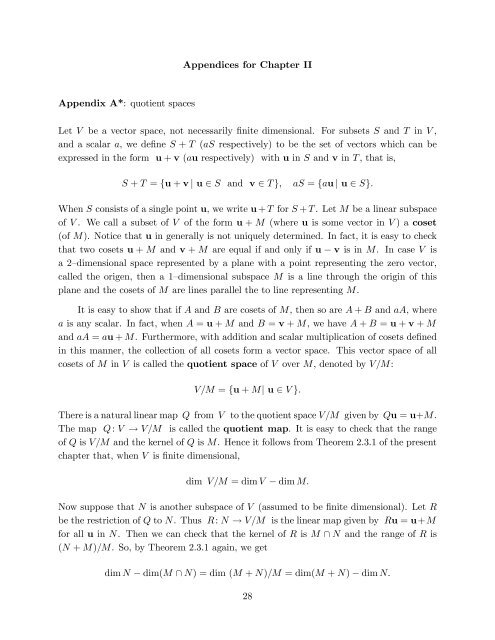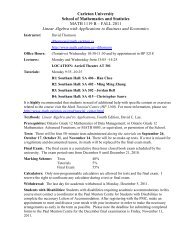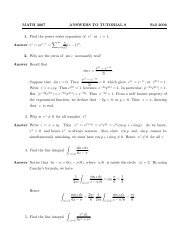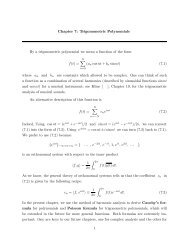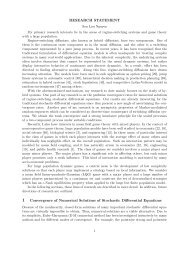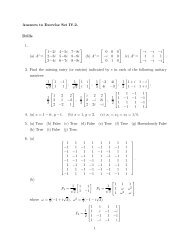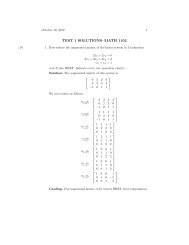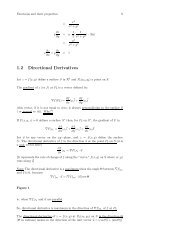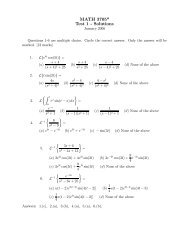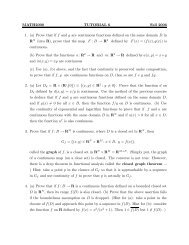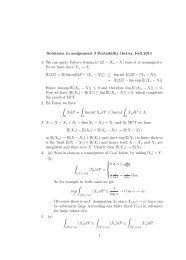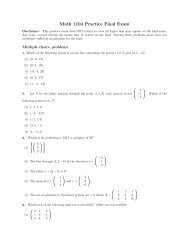CHAPTER II DIMENSION In the present chapter we investigate ...
CHAPTER II DIMENSION In the present chapter we investigate ...
CHAPTER II DIMENSION In the present chapter we investigate ...
Create successful ePaper yourself
Turn your PDF publications into a flip-book with our unique Google optimized e-Paper software.
Appendix A*: quotient spaces<br />
Appendices for Chapter <strong>II</strong><br />
Let V be a vector space, not necessarily finite dimensional. For subsets S and T in V ,<br />
and a scalar a, <strong>we</strong> define S + T (aS respectively) to be <strong>the</strong> set of vectors which can be<br />
expressed in <strong>the</strong> form u + v (au respectively) with u in S and v in T , that is,<br />
S + T = {u + v | u ∈ S and v ∈ T }, aS = {au | u ∈ S}.<br />
When S consists of a single point u, <strong>we</strong> write u + T for S + T . Let M be a linear subspace<br />
of V . We call a subset of V of <strong>the</strong> form u + M (where u is some vector in V ) a coset<br />
(of M). Notice that u in generally is not uniquely determined. <strong>In</strong> fact, it is easy to check<br />
that two cosets u + M and v + M are equal if and only if u − v is in M. <strong>In</strong> case V is<br />
a 2–dimensional space re<strong>present</strong>ed by a plane with a point re<strong>present</strong>ing <strong>the</strong> zero vector,<br />
called <strong>the</strong> origen, <strong>the</strong>n a 1–dimensional subspace M is a line through <strong>the</strong> origin of this<br />
plane and <strong>the</strong> cosets of M are lines parallel <strong>the</strong> to line re<strong>present</strong>ing M.<br />
It is easy to show that if A and B are cosets of M, <strong>the</strong>n so are A + B and aA, where<br />
a is any scalar. <strong>In</strong> fact, when A = u + M and B = v + M, <strong>we</strong> have A + B = u + v + M<br />
and aA = au + M. Fur<strong>the</strong>rmore, with addition and scalar multiplication of cosets defined<br />
in this manner, <strong>the</strong> collection of all cosets form a vector space. This vector space of all<br />
cosets of M in V is called <strong>the</strong> quotient space of V over M, denoted by V/M:<br />
V/M = {u + M| u ∈ V }.<br />
There is a natural linear map Q from V to <strong>the</strong> quotient space V/M given by Qu = u+M.<br />
The map Q : V → V/M is called <strong>the</strong> quotient map. It is easy to check that <strong>the</strong> range<br />
of Q is V/M and <strong>the</strong> kernel of Q is M. Hence it follows from Theorem 2.3.1 of <strong>the</strong> <strong>present</strong><br />
<strong>chapter</strong> that, when V is finite dimensional,<br />
dim V/M = dim V − dim M.<br />
Now suppose that N is ano<strong>the</strong>r subspace of V (assumed to be finite dimensional). Let R<br />
be <strong>the</strong> restriction of Q to N. Thus R: N → V/M is <strong>the</strong> linear map given by Ru = u+M<br />
for all u in N. Then <strong>we</strong> can check that <strong>the</strong> kernel of R is M ∩ N and <strong>the</strong> range of R is<br />
(N + M)/M. So, by Theorem 2.3.1 again, <strong>we</strong> get<br />
dim N − dim(M ∩ N) = dim (M + N)/M = dim(M + N) − dim N.<br />
28


